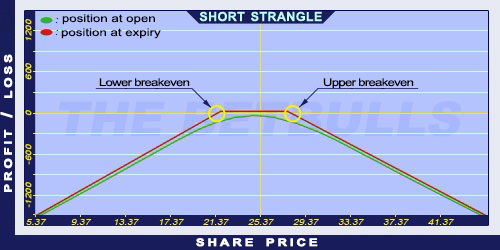Description and use
Short Strangle is a version of the Short Straddle strategy. The difference is the wider range of breakeven points, which increases the probability of the profitability. Instead of selling ATM options, OTM Call and Put options are sold to enhance profitability. Short Strangle is the opposite of Long Strangle strategy. Both components have unlimited risk. When shares are fluctuating in both directions, the position is highly uncertain. When shares are moving within a given range, the profits are limited. The direction of the market is neutral. The trader speculates on sideway prices movements. The volatility is expected to decrease in the future. However, higher implied volatility is ideal. The duration of the strategy should be one month or less. This is duration is highly recommended, because of the potential unlimited risk.
- Type: Neutral
- Transaction type: Credit
- Maximum profit: Limited
- Maximum loss: Unlimited
- Strategy: Neutral strategy
Opening the position
- Sell lower strike (OTM) Put options (maturity is one month or less).
- Sell higher strike (OTM) Call options (same quantity and expiration as the Put options’).
Steps
Entry:
- Make sure the share prices are moving within certain limits.
- The trading should take place in a period when no news (related to the underlying shares) is expected.
Exit:
- Buy back the options when it is making profit.
Basic characteristics
Maximum loss: Unlimited.
Maximum profit: Received net credit.
Time decay: Time decay has a positive effect on the value.
Lower breakeven point: Lower strike price - Net Credit.
Upper breakeven point: Higher strike price + Net Credit.
Advantages and disadvantages
Advantages:
- The investor can profit from share prices moving within given limits.
- The strategy has a relatively high expected return.
Disadvantages:
- Too risky at the breakeven points.
- Limited profit.
- Highly risky strategy, not recommended to beginners.
Closing the position
Closing the position:
- Buy back the Call and Put options.
Mitigation of losses:
- Buy back the sold options.
Example
ABCD is traded for $25.37 on 17.05.2017. Then investor sells a Short Put option which has a strike price of $22.50, expires in June 2017. and costs $0.35 (premium). Then he sells a Short Call option which has a strike price of $27.50, expires in June 2017. and costs $0.65 (premium).
Price of the underlying (share price): S= $25.37
Premium (Short Put): P= $0.35
Premium (Short Call): C= $0.65
Strike price (Short Put): KP= $22.50
Strike price (Short Call): KC= $27.50
Net credit: NCr
Maximum loss: R
Maximum profit: Pr
Lower breakeven point: LBEP
Upper breakeven point: UBEP
Net credit: NCr = P + C
Maximum loss (risk): Unlimited
Maximum profit: Pr = NCr
Lower breakeven point: LBEP = KP - NCr
Upper breakeven point: UBEP = KC + NCr
NCr = $1.00
R = unlimited
Pr = $1.00
LBEP = $21.50
UBEP = $28.50














